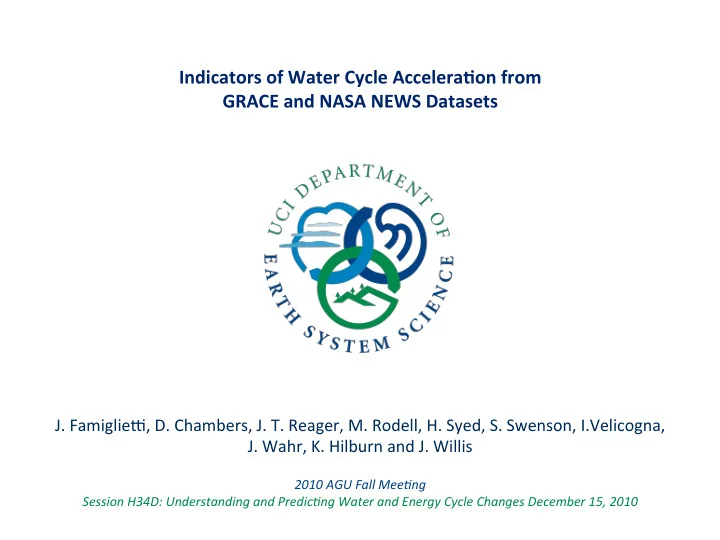

!"#$%&'()*+(,+-&'.)+/0%1.+2%%.1.)&3("+,)(4++ 562/7+&"#+8292+87-9+:&'&*.'*+ !"#$%&'()'*+,#-"#./%&0*12,#!"#3"#4*%(*1,#5"#467*)),#8"#9:*7,#9"#9;*<26<,#=">*)'?6(<%,## !"#@%/1,#A"#8')0B1<#%<7#!"#@'))'2# # !"#"$%&'$()**$+,,-./$ 0,1123.$45678$'.9,:1;).92./$).9$<:,92=-./$>);,:$).9$?.,:/@$A@=*,$AB)./,1$7,=,CD,:$#EF$!"#"$ #
;<'1$".+ • � -*C<'D6<#6E#;%F*1#?:?)*#%??*)*1%D6<# • � @/%F#;*#&'(/F#*GH*?F#F6#2**#I2"#;/%F#;*#%1*#2**'<(# - � J&H/%2'2#6<#2FB7:#6E#2F61%(*#I%1'%D6<2#61#?6<2F1%'<'<(# ;%F*1#0%)%<?*#;'F/#2F61%(*# • � 86;#;'))#F/*#;%F*1#?:?)*#0*/%I*#'<#F/*#EBFB1*K# • � @/%F#2/6B)7#;*#0*#76'<(#%06BF#'FK#
-&'.)+/0%1.+2%%.1.)&3("+ • � =<#%#;%1&'<(#?)'&%F*,#;*#?%<#*GH*?F#&61*#*I%H61%D6<,#%<7# F/B2#&61*#H1*?'H'F%D6<#%<7#&61*#1B<6L,#'"*"#0'((*1#*G?/%<(*2# 61#&61*#?:?)'<(#6E#;%F*1#'<#F/*#;%F*1#?:?)*# • � 567*)2#2B((*2F#%<7#602*1I%D6<2#%1*#0*('<<'<(#F6#'<7'?%F*#F/%F# F/*#&%(<'FB7*#%<7#E1*MB*<?:#6E#/:716)6('?#*GF1*&*2#6E# N667'<(#%<7#716B(/F#;'))#%)26#'<?1*%2*# • � $B1F/*1&61*,#&67*)2#2B((*2F#%#1*7'2F1'0BD6<#6E#H1*?'H'F%D6<# E16&#F/*##&'7O)%DFB7*2,#F6#/'(/#%<7#)6;#)%DFB7*2# • � P4Q.J#'2#0*('<<'<(#F6#?6<F1'0BF*#F6#2FB7'*2#6E#;%F*1#?:?)*# ?/%<(*#0:#?)62'<(#F/*#;%F*1#0B7(*F,#%<7#%)26#0:#H16I'7'<(# 26&*#<*;#2F61%(*,#1%F/*1#F/%<#NBGO0%2*7#&*F1'?2"###
-=&'+4$>='+?.+.@A.%'+'(+*..B+ 87-9C+9'&'.+(,+'=.+51(D&1+-&'.)+/0%1.+ 414.0 75.3 111.3 378.0 36.0 Global mean water fluxes (1,000 km 3 /yr) at the start of the 21 st century, based on satellite and ground-based observations and data integrating models. A comprehensive assessment of the global water cycle is being carried out by a multi-institutional team of investigators supported by NASA’s Energy and Water Cycle Study (NEWS) program. !"#$#%&'$()(*+,&"',+-./#-,0#&'$,%1%-',$'23($'4,5#&#,#*5,'67'$84',&"#&,%#*, .*-1,/',"#$*'44'5,&"$.3+",#*,(*&'+$#89',&'#:,';.$&<,#4,(4,=.4&'$'5,/1,>?@A, Matthew.Rodell@nasa.gov
-=&'+4$>='+?.+.@A.%'+'(+*..B+ E O P O E L P L Q A Q L S O S L
What do we see? P)60%)#6?*%<#*I%H61%D6<#E16&#RQ$)BG,#8RQS9,#995T=# 5*%<#6E##RQ$)BG,#8RQS9,#995T=,#%<<B%)#?:?)*#1*&6I*7# 2000 − 5 199507 199607 199707 199807 199907 200007 200107 200207 200307 200407 200507 200607 3.8x 104 3.48 (b) 3.7 3.46 Evaporation (10 km ³ /month) 3.6 3.44 Evaporation (km /month) 3.5 4 3 3.42 3.4 3.3 3.4 3.2 3.38 3.1 199412-200611: 768 km 3 /yr 2 ; p < 0.001 3.36 199412-199906: 2256 km 3 /yr 2 ; p < 0.001 3 199907-200611: 396 km 3 /yr 2 ; p < 0.001 OAFlux HOAP S SSM/I 3.34 2.9 199507 199607 199707 199807 199907 200007 200107 200207 200307 200407 200507 200607 199407 199507 199607 199707 199807 199907 200007 200107 200207 200307 200407 200507 200607 3.18 Time (YearMonth) Figure S5 Syed et al., 2010
What do we see? P)60%)#6?*%<#H1*?'H'F%D6<#E16&#PS.S#%<7#.5QS# 5*%<#6E#PS.S#%<7#.5QS,#%<<B%)#?:?)*#1*&6I*7# 199507 199607 199707 199807 199907 200007 200107 200207 200307 200407 200507 200607 3.5x 104 3.18 GPCP (c) CMAP 3.4 3.16 3.3 Precipitation (10 km ³ /month) Precipitation (km /month) 3.14 3.2 3 3.12 4 3.1 3 3.1 2.9 3.08 2.8 3.06 199412-200611: 240 km 3 /yr 2 ; p < 0.01 2.7 199412-199906: -720 km 3 /yr 2 ; p < 0.01 199907-200611: 1260 km 3 /yr 2 ; p < 0.001 2.6 3.04 199407 199507 199607 199707 199807 199907 200007 200107 200207 200307 200407 200507 200607 199507 199607 199707 199807 199907 200007 200107 200207 200307 200407 200507 200607 Time (YearMonth) Time (YearMonth) Figure S4 Figure 2 Syed et al., 2010
What do we see? R = � M + E � P &*3D)*$921=B):/,$-C,$1,:2,1F$#GG6H!""I$ $ 6+ U#P)60%)#E1*2/;%F*1#7'2?/%1(* + 12000 4.6 x 104 Discharge %<<B%)#7'2?/%1(*# EF #U#P)60%)#6?*%<#&%22#?/%<(*# 4.4 4.2 Discharge (km3/yr) E16TS#V#!%26<OW#&*%<#2*%#)*I*)# 4 10000 3.8 I%1'%D6<2"# 3.6 3.4 @*#?6&H%1*7#P4Q.J#X5#;'F/# 3.2 8000 3 /month) 2.8 F/%F#?6&HBF*7#B2'<(#Q4PR#N6%F2,# ‘94‘95‘96‘97‘98‘99‘00‘01‘02‘03‘04‘05‘06 Year Discharge (km3 %<7#F6#=2/''#YZ[[\]#%<7#=<()*0:#%<7# 6000 8B77)*2F6<#YZ[[^]"#.6&H%1'26<2# ;*1*#E%I61%0)*#26#;*#B2*7#06F/# 4000 =2/''#%<7#=8#F6#?6&HBF*#()60%)# 7'2?/%1(*## 2000 7 #U#P)60%)#6?*%<#*I%H61%D6<# YE16&#RQ$)BG,#8RQS9,#995T=]# &6<F/):#7'2?/%1(*# 0 G #U#P)60%)#6?*%<#H1*?'H'F%D6<# YE16&#.5QS#%<7#PS.S]# 199407 199507 199607 199707 199807 199907 200007 200107 200207 200307 200407 200507 200607 Time (YearMonth) Figure 1 ?C,:/2./$;:,.91$1B3J$2.=:,)1,$2.$921=B):/,$3K$E6"$LC 5 M@: ! $3:$#NEOM@:$K3:$;B,$#5H@,):$-C,$P,:239$ Syed et al., 2010
-=&'+4$>='+?.+.@A.%'+'(+*..B+ E O P O E L P L Q A Q L S O S L
What do we see? 5%22#?/%<(*2#'<#()60%)#;%F*1#1*2*1I6'12#E16&#P4Q.J,#Z[[ZOZ[W[# 31*<72#Y&&T:1]# R?*%<#_#W"Z`#["a## b%<7#_#["a#`#["c# P1**<)%<7#_# H ["\[#`#["W# Q<F%1?D?%#_# H ["d[#`#["Z##
What do we see? 7,;:,.9,9$3=,).$C)11$-C,$1,:2,1$ • � Q&H)'FB7*#6E#%<<B%)#2F61%(*# ?:?)*#H16I'7*2#%#7'1*?F#&*%2B1*# 6E#;%F*1#?:?)*#2F1*<(F/# • � ./%<(*2#'<#%&H)'FB7*#H16I'7*#%# <*;,#'<F*(1%F*7#%<7#&*%2B1%0)*# &*F1'?#6E#;%F*1#?:?)*# %??*)*1%D6<# • � Q&H)'FB7*#6E#06F/#)%<7#%<7# 7,;:,.9,9$*).9$J);,:$C)11$-C,$1,:2,1$ 6?*%<#2F61%(*#2'(<%)#/%2# '<?1*%2*7#0:#["a#&&T:1# • � R?*%<#?/%<(*2#'<#F/'2#D&*# H*1'67#%1*#H1'&%1'):#7B*#F6# '<?1*%2'<(#*I%H61%D6<,#1'I*1# 7'2?/%1(*#%<7#'?*#&*)D<(#
-=&'+4$>='+?.+.@A.%'+'(+*..B+ =S..#Q4d,#S16e*?F*7#S%f*1<2#6E#S1*?'H'F%D6<#./%<(*# $'(B1*#9S5"^"#4*)%DI*#?/%<(*2#'<#H1*?'H'F%D6<#Y'<#H*1?*<F]#E61#F/*#H*1'67#Z[g[hZ[gg,# 1*)%DI*#F6#Wgi[hWggg"#>%)B*2#%1*#&B)DO&67*)#%I*1%(*2#0%2*7#6<#F/*#94J9#QWj# 2?*<%1'6#E61#-*?*&0*1#F6#$*01B%1:#Y)*k]#%<7#!B<*#F6#QB(B2F#Y1'(/F]"#@/'F*#%1*%2#%1*# ;/*1*#)*22#F/%<#\\l#6E#F/*#&67*)2#%(1**#'<#F/*#2'(<#6E#F/*#?/%<(*#%<7#2DHH)*7#%1*%2# %1*#;/*1*#&61*#F/%<#g[l#6E#F/*#&67*)2#%(1**#'<#F/*#2'(<#6E#F/*#?/%<(*"##
What do we see? 31*<72#'<#$1*2/;%F*1#9F61%(*#E16&#P4Q.J,#Z[[ZOZ[W[# ? ? ()C2/*2,Q$,;$)*NF$!"##F$2.$P:,P$
H(?+?$11+'=.+?&'.)+%0%1.+D.=&I.+$"+'=.+,<'<).B+ + B+ B+ '<?1*%2'<():# 3*&H# *<*1(*D?#;%F*1#?:?)*# ()%?'%)# '<F*1()%?'%)# ()%?'%)# 3'&*#
Summary • � A largely storage driven assessment of water cycle change suggests that water cycle acceleration is the norm. • � NASA NEWS project is providing new metrics to quantify and understand these changes • � These and other metrics and datasets will be carefully monitored in the coming years as part of a comprehensive and ongoing assessment of the state of the water cycle • � The implications for increasing energetics, i.e. for changes in extremes, must be very carefully evaluated. It is not clear that our models can yet reproduce some the the metrics we discussed today, and therefore accurately predict future changes • � Data acquisition and model development should focus on better characterizaton and prediction of these changes. Dissemination of key advances and results should target informed decision making.
Recommend
More recommend